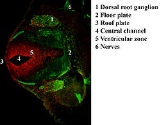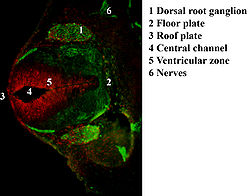
Neurofilament
Encyclopedia
Neurofilaments are the 10 nanometer (10nm) intermediate filaments found specifically in neurons. They are a major component of the cell's cytoskeleton, and provide support for normal axonal radial growth (i.e. increases in axon's diameter). Neurofilaments are composed of polypeptide chains or subunits that are related structurally to the intermediate filaments of other tissues such as keratin
subunits, which make 10nm filaments expressed specifically in epithelia. The family of proteins making intermediate filaments is divided into 5 major classes, the keratins forming the classes I and II. Class III contains the proteins Vimentin, Desmin, Peripherin and Glial Fibrillary Acidic Protein (GFAP). The major neurofilament subunits occupy the class IV family of intermediate filaments. Finally class V contains the nuclear lamins.
:
The SDS-PAGE molecular weights vary between mammalian species, with larger species usually having larger proteins. The real molecular weights of these proteins are considerably lower than the SDS-PAGE estimates, particularly in the case of NF-H and NF-M. This is due to the highly charged C-terminal regions of the molecules. Neurofilaments are found in vertebrate neurons in especially high concentrations in axon
s, where they appear to regulate axonal diameter.
A fourth class IV subunit alpha-internexin
, a.k.a. NF66, is found in association with NF-L, NF-M and NF-H in many situations and is expressed earlier in development than the other neurofilament proteins.
A fifth protein belonging to class IV, Nestin
, is found in developing neurons and glia, and the presence of this protein is widely used to define neural stem cells. This protein is lost as development proceeds.
The class III intermediate filament protein subunit peripherin
is found in neurofilaments along with the class IV subunits in a few neurons, mostly in the peripheral nervous system
. Finally another class III intermediate filament subunit, vimentin
, is found in developing neurons and a few very unusual neurons in the adult in association with class IV proteins, such as the horizontal neurons of the retina.
In the adult mammal neurofilament subunit proteins coassemble in vivo
, forming a heteropolymer
that contain NF-L or alpha-internexin plus NF-M or NF-H. Peripherin and vimentin may incorporate into neurofilaments along with these proteins. The NF-H and NF-M proteins have lengthy C-terminal tail domains that appear to control the spacing between neighboring filaments, generating aligned arrays with a fairly uniform interfilament spacing as seen in axons.
 During axonal growth, new neurofilament subunits are incorporated all along the axon in a dynamic process that involves the addition of subunits along the filament length, as well as the addition of subunits at the filament ends.
During axonal growth, new neurofilament subunits are incorporated all along the axon in a dynamic process that involves the addition of subunits along the filament length, as well as the addition of subunits at the filament ends.
After an axon has grown and connected with its target cell, the diameter of the axon may increase as much as fivefold.
Neurofilaments are able to determine the diameter of dendrites and axons because their polarity causes them to repel each other.
The level of neurofilament gene expression seems to directly control axonal diameter, which in turn controls how fast electrical signals travel down the axon.
Mutant mice with neurofilament abnormalies have phenotypes resembling amyotrophic lateral sclerosis
.
. It is useful for differentiating neurons (positive for NF) from glia (negative for NF).
Keratin
Keratin refers to a family of fibrous structural proteins. Keratin is the key of structural material making up the outer layer of human skin. It is also the key structural component of hair and nails...
subunits, which make 10nm filaments expressed specifically in epithelia. The family of proteins making intermediate filaments is divided into 5 major classes, the keratins forming the classes I and II. Class III contains the proteins Vimentin, Desmin, Peripherin and Glial Fibrillary Acidic Protein (GFAP). The major neurofilament subunits occupy the class IV family of intermediate filaments. Finally class V contains the nuclear lamins.
Subunit Proteins of Neurofilaments
The three major neurofilament subunits were discovered from studies of proteins transported down axons. Proteins are synthesized within the cell body, and hence they must travel along an axon to reach their final destination. The names given to the three major neurofilament subunits are based upon the apparent molecular weight of the mammalian subunits on SDS-PAGESDS-PAGE
SDS-PAGE, sodium dodecyl sulfate polyacrylamide gel electrophoresis, describes a collection of related techniques widely used in biochemistry, forensics, genetics and molecular biology to separate proteins according to their electrophoretic mobility...
:
- the light or lowest (NF-L) runs at 68-70kDa
- the medium or middle (NF-M) runs at about 145-160kDa
- the heavy or highest (NF-H) runs at 200-220kDa
The SDS-PAGE molecular weights vary between mammalian species, with larger species usually having larger proteins. The real molecular weights of these proteins are considerably lower than the SDS-PAGE estimates, particularly in the case of NF-H and NF-M. This is due to the highly charged C-terminal regions of the molecules. Neurofilaments are found in vertebrate neurons in especially high concentrations in axon
Axon
An axon is a long, slender projection of a nerve cell, or neuron, that conducts electrical impulses away from the neuron's cell body or soma....
s, where they appear to regulate axonal diameter.
A fourth class IV subunit alpha-internexin
Internexin
Internexin, alpha-internexin, is a Class IV intermediate filament approximately 66 KDa. The protein was originally purified from rat optic nerve and spinal cord. The protein copurifies with other neurofilament subunits, as it was originally discovered, however in some mature neurons it can be the...
, a.k.a. NF66, is found in association with NF-L, NF-M and NF-H in many situations and is expressed earlier in development than the other neurofilament proteins.
A fifth protein belonging to class IV, Nestin
Nestin (protein)
Nestin is a type VI intermediate filament protein. These intermediate filament proteins are expressed mostly in nerve cells where they are implicated in the radial growth of the axon...
, is found in developing neurons and glia, and the presence of this protein is widely used to define neural stem cells. This protein is lost as development proceeds.
The class III intermediate filament protein subunit peripherin
Peripherin
Peripherin is a protein that in humans is encoded by the PRPH gene.Peripherin is a type III Intermediate filament protein expressed mainly in neurons of the peripheral nervous system. It is also found in neurons of the central nervous system that have projections toward peripheral structures, such...
is found in neurofilaments along with the class IV subunits in a few neurons, mostly in the peripheral nervous system
Peripheral nervous system
The peripheral nervous system consists of the nerves and ganglia outside of the brain and spinal cord. The main function of the PNS is to connect the central nervous system to the limbs and organs. Unlike the CNS, the PNS is not protected by the bone of spine and skull, or by the blood–brain...
. Finally another class III intermediate filament subunit, vimentin
Vimentin
Vimentin is a type III intermediate filament protein that is expressed in mesenchymal cells. IF proteins are found in all metazoan cells as well as bacteria. IF, along with tubulin-based microtubules and actin-based microfilaments, comprise the cytoskeleton...
, is found in developing neurons and a few very unusual neurons in the adult in association with class IV proteins, such as the horizontal neurons of the retina.
In the adult mammal neurofilament subunit proteins coassemble in vivo
In vivo
In vivo is experimentation using a whole, living organism as opposed to a partial or dead organism, or an in vitro controlled environment. Animal testing and clinical trials are two forms of in vivo research...
, forming a heteropolymer
Heteropolymer
A heteropolymer or copolymer is a polymer derived from two monomeric species, as opposed to a homopolymer where only one monomer is used...
that contain NF-L or alpha-internexin plus NF-M or NF-H. Peripherin and vimentin may incorporate into neurofilaments along with these proteins. The NF-H and NF-M proteins have lengthy C-terminal tail domains that appear to control the spacing between neighboring filaments, generating aligned arrays with a fairly uniform interfilament spacing as seen in axons.
Growth

After an axon has grown and connected with its target cell, the diameter of the axon may increase as much as fivefold.
Neurofilaments are able to determine the diameter of dendrites and axons because their polarity causes them to repel each other.
The level of neurofilament gene expression seems to directly control axonal diameter, which in turn controls how fast electrical signals travel down the axon.
Mutant mice with neurofilament abnormalies have phenotypes resembling amyotrophic lateral sclerosis
Amyotrophic lateral sclerosis
Amyotrophic lateral sclerosis , also referred to as Lou Gehrig's disease, is a form of motor neuron disease caused by the degeneration of upper and lower neurons, located in the ventral horn of the spinal cord and the cortical neurons that provide their efferent input...
.
Use in diagnostic pathology
Neurofilament, NF, immunostaining is common in diagnostic neuropathologyNeuropathology
Neuropathology is the study of disease of nervous system tissue, usually in the form of either small surgical biopsies or whole autopsy brains. Neuropathology is a subspecialty of anatomic pathology, neurology, and neurosurgery...
. It is useful for differentiating neurons (positive for NF) from glia (negative for NF).

